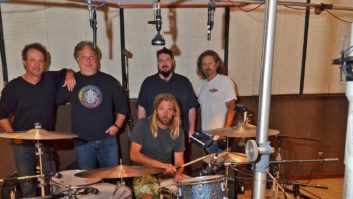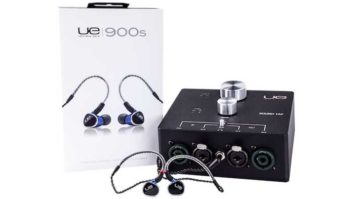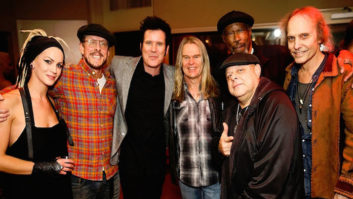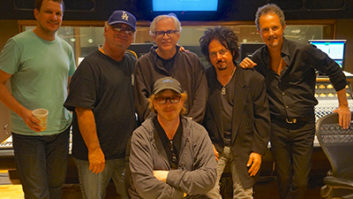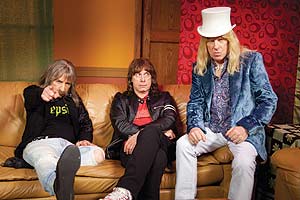
This is (still) Spinal Tap, L-R: Harry Shearer as Derek Smalls, Christopher Guest as Nigel Tufnel and Michael McKean as David St. Hubbins.
Photo: Matt Mindlin
During this 25th anniversary of the film and album This is Spinal Tap, the band has reunited to set the record straight, once and for all. What a stupendous relief for the countless fans who empathized with Tap’s well-documented fall from grace and money. All of the original album has been re-recorded, along with much anticipated never-released material for a total of 19 tracks. The release, out June 16, also includes a one-hour DVD and a pop-up diorama package that unveils three 12-inch action figures of the band and a proportionally sized Stonehenge.
Tracking for Back From the Dead took place at The Village in L.A. with engineer Ed Cherney and longtime Tap collaborator CJ Vanston producing. Guest artists include Phil Collen of Def Leppard, John Mayer, Keith Emerson and Steve Vai.
Cherney mixed half of the thunderous new album at his Studio Ed at The Village, while Vanston mixed the ear-splitting remainder at his studio, The Treehouse. Mastering was done by Gavin Lurssen with publicist Bobbi Fleckman peering over his shoulder.
Vanston explains, “Spinal Tap is re-recording the entire first album because they thought the original album was a hatchet job, just like the movie.” With worldwide attention focused on Tap’s triumphant independent release of Back From the Dead on The Label Industry Records, a Rock Band 2 music videogame in the works and a one-stop world tour planned for London’s Wembley Stadium, this is surely one of the most anticipated juggernauts of comic/tragic music mayhem ever conceived and/or executed.
And now, join me at The Village with the blond and effervescent David St. Hubbins, the master of the big-bottom bass, Derek Smalls, the moody yet severely gifted Nigel Tufnel, and natty tweakster CJ Vanston.
Catching Up With the Guys
We’re going to dig under the surface and try to find out a little bit more about this new recording.
St. Hubbins: We don’t care if you dig under the surface, just as long as you sterilize the instrument first.
Smalls: And find the surface buried underneath.
Rumor has it that this was the most difficult Spinal Tap album to record. Is that true?
St. Hubbins: I wouldn’t say that it was the most difficult. We had a good time. We did a lot of the old songs. It was sort of like old wine in, well, not new bottles — the bottles were old, as well — but they are packed in a really high-impact space-age plastic carrying thing.
Smalls: New labels. No corks.
A lot has happened in the…
Smalls: Not really.
No, not really, but some things have happened since the first album.
St. Hubbins: Oh, yeah.
And now we have all this digital manipulation. I just wondered if you guys resorted to any of that Auto-Tuning trickery.
St. Hubbins: Technological jiggery-pokery, is that what you’re saying? Oh, yes, we love it. Especially CJ Vanston. We just look over, and there is CJ fiddling with something. We say, “Put that away and get started on the music,” and then he starts doing all this digital stuff. He’s explaining it to us, but we don’t understand half of it. But we know that when he tweaks it, it stays tweaked.
Ed Cherney had something to do with recording this album. I believe he recorded the tracks. Ed’s really known for his work with many, many artists, especially Bonnie Raitt. Do you think that there’s a Bonnie Raitt intimacy with this new album?
Smalls: There’s a cut-rate intimacy with this album.
St. Hubbins: I wish Bonnie had shown up. She’s always pleasant to have around. You know, she was off waltzing with Castro. She’s very politically involved.
Smalls: Which Castro would that be?
St. Hubbins: Fidel.
Smalls: He’s dead.
St. Hubbins: No, he’s not.
Vanston: Lenny Castro, the percussionist.
St. Hubbins: I think that Ed does bring that chummy quality. Very true.
Smalls: There was chum in the studio every day.
St. Hubbins: That’s right, throwing out the chum for us sharks.
I am interested in what you guys think about the rampant digital bootlegging and ripping off of all the material you worked on for so many years. How do you deal with that?
St. Hubbins: Listen, we’ve been ripped off as much as anyone. Some of the basic licks, some of the stuff that Nigel comes up with — wait for five minutes and somebody has ripped it off.
Smalls: We’ve been ripped off by almost everyone.
St. Hubbins: By the best.
Smalls: By the best, by the f***ing best, by every major…
St. Hubbins: That’s how they got to be the best.
Smalls: That’s how they got their lifestyle, how they got their fancy cars, their great homes in the Hollywood Hills. So now it’s the punter’s turn. Now everybody can act like a record executive.
We’re really looking forward to hearing the new Spinal Tap material.
Smalls: We’re very proud of “Warmer Than Hell,” which has never been recorded, and “Short and Sweet,” and our legendary long jam is coming out on this record: “Jazz Oddyssey.”
St. Hubbins: A couple of the re-dos, as well: “Funky Sex Farm,” “Reggae Flower People.”
A Few Words From CJ Vanston
When did you first work with Spinal Tap?
Vanston: I played a concert with them in 1991 at the Disneyland Hotel. Dweezil Zappa and Steve Lukather sat in, and it was an amazing night. Drum legend Russ Kunkel was responsible for that, and I’ll never forgive him.
What do you do for Spinal Tap?
Vanston: I have multiple functions with Tap, ranging from being their producer, keyboard player, musical director, photographer and archivist, et cetera. I also find Chinese restaurants in each city that still use MSG. Hard to find these days, but the boys love their MSG.
Why do you call your studio The Treehouse?
Vanston: It’s my hideout, my sanctuary, and until recently there were no girls allowed.
Primary equipment?
Vanston: The studio definitely centers around Logic 8 and my Macs. Every day I shake my head in astonishment at Logic. It is infinitely customizable — I have dozens of templates for working in video, live mixing, mastering, et cetera. Sometimes I think back to how we used to work and wonder how we got it done. The biggest advantage to today’s technology is the ability to jump around from song to song. Since I am an “in-the-box” guy, there are no knobs to recall when switching projects or songs.
I couldn’t live without my Mackie Control. That changed my life. To be able to grab a fader and do a quick duck or ride means that every move I do is moving me closer to the finished product. The fact that it’s so small is a huge plus for a guy like me, who does most of his own engineering, allowing it to sit to my side instead of gobbling up valuable real estate.
I also have a vintage keyboard room that is full of tasty artifacts from the era of analog synths. There is nothing like these old beasts. They shake the room while the plug-ins lie limp. My Oberheim 4-voice is all over this new Spinal Tap record, as is my Jupiter-8 and Yamaha TX816s. I also use the Alesis Andromeda, a more recent analog synth — I don’t know how it ever got made as it is an expensive tool for a small market. Kind of like this band. I am also absolutely loving my ZenDrum! David Haney came up with a superior trigger technology to make drum programming fun and creative.
How do you get the group’s massive drum sound?
Vanston: We have a massive drummer, Skippy Skuffleton [aka Gregg Bissonette]. We really tried to fatten him up for this record. He lives in a motor home that he parks outside the studio, and we send Mexican food out to him at regimented intervals. Of course, it takes a special engineer to capture the sheer violence when Skippy is trying to finish the track to make a run for the loo. That would be Ed Cherney, the only guy Skippy will let closer than 10 feet to his drums.
Blue Microphones sent over some very expensive mics for us to use. The big ones are called Blue Bottles, and I think Skipper Wise at Blue wanted us to try them on vocals. I shied away from this because the guys have a bad track record with mic stands. They’re actually rather clumsy and can’t be trusted with expensive equipment. So we used the Blue Bottles as overheads, out of harm’s way. They sounded fantastic.
How do you get that huge bass sound?
Vanston: Derek has an amp that has tubes from a Russian fighter jet in it. Some guy in Latvia built the electronics. The speaker cones are actually woven by hand, although we recently discovered that those hands were children’s hands in China. After a long deliberation, we decided that only enhanced the childish innocence that Derek brings to the band. Ed also uses some Tube-Tech multiband compressor on it to rein in the terror that is Derek’s bass part.
How do you get that breathtaking guitar sound?
Vanston: What is interesting is how well David St. Hubbins and Nigel Tufnel complement each other’s guitar sounds. Nigel, as you know, has his amps built special — at least the knobs are special — but David is happy with whatever happens to be in the studio. We used amp boxes to keep the leakage to a minimum. The Village has a really great studio [D] that has lots of nooks and crannies to put all the extra cabinets that Nigel and David use. But when it comes down to it, it’s the sheer rage that they both play with. I put down a ban on all therapy during the making of this record. The last thing we want is a bunch of happy guys playing all la-la rainbows and daisies.
How do you get those superhuman vocals?
Vanston: Well, I insist on cutting them live, all three guys in the room, no tricks. Then we comp them, tune them, compress them, fix the timing issues, use special de-essers that take the natural harshness out of their voices, fly all the choruses and re-cut whatever isn’t working. All in all, we try and keep it natural and live.
What parts do you play and why?
Vanston: I lean toward simple parts that speak above the din. That can be a challenge with a band this loud. Plus, nobody really wants to hear the keyboards. I think that is Viv Savage’s fault; he really ruined it for me, he painted in broad swaths. I will say that there are literally hundreds of subliminal parts lurking below the surface for the true fans. Keith Emerson was a huge influence on me, yet I’m unable to use any of that influence for this band on this record. There is just no room. So I tend to distort things so the guys think they are guitar sounds, thus they stay on the record.
More From the Lads
Derek, you and your bass. How do you stay ahead?
St. Hubbins: He’s usually a bit behind, actually.
Smalls: Behind is where you want to be. You don’t want to be ahead. The pocket is behind. Where are the pockets on your trousers? Behind. It’s a clue.
St. Hubbins: You’ve done some work on your bass sound over the years.
Smalls: Oh yeah, fattened it up.
St. Hubbins: Thickened it up.
How?
Smalls: Oh, just working with different pickups and different kinds of strings.
Tufnel: Mainly, his fingers are fatter now. That helps. Chubby fingers.
Smalls: It’s true. Hard to get fatter than these fingers.
St. Hubbins: Squat little bastards.
Smalls: Sausages.
Like a farmer.
St. Hubbins: Like a Sex Farmer.
David, you have such an incredible singing voice. Did you have training as a boy?
Tufnel: He had training as a boy…
Smalls: But it didn’t take.
St. Hubbins: I had training with a boy. I don’t discuss that much. I was going to say that I used to sing with the choir in church. I didn’t. I sang along with the choir.
Smalls: You were outside the church.
St. Hubbins: I was outside the church having a smoke and I heard them and I was inspired and I would sing along. But I never sang publicly until I became a rock ‘n’ roller.
Tufnel: We used to be outside and the choirmaster used to come out, and say, “Hubbins, get in here.” He said, “No, I’m not doing it.” He used to take a drag and then flick his cigarette away. Always a rebel, even then. Nine years old. Beautiful voice, even as a child.
St. Hubbins: Thank you very much. Actually, my mum was thinking of having me castrated to keep that nice falsetto.
Vanston: Castrati.
St. Hubbins: I talked her out of it.
Smalls: What didja tell her?
St. Hubbins: I said, “Put down that knife mum.”
Tufnel: It was actually a carrot peeler. Horrible thought.
Vanston and Cherney Together
The sound is as big and bad as any heavy metal out there. Were you trying to surpass all the metal competition?
Cherney: Well, the sound comes from the musicians. That is what Spinal Tap sounds like. If you can capture that by putting some microphones up and opening them up, that’s what you get. Big, big and more big.
Vanston: And angry.
Cherney: Bitter. They’re not very nice anymore.
Yes, I noticed. One of them told me to f*** myself during my interview with them.
Cherney: Only one told you that? All of them told me that. You want to know the truth about recording Spinal Tap? They are really good musicians, and some people might not know that. Basically, you set them up in a room and they are all sitting together and they can see each other and they play the songs. That is the secret. Put some microphones up and capture their performance.
Was much improvisation done in the studio?
Vanston: No, we rehearsed for a week before we came in here and played the songs. There’s not a whole lot of wizardry going on. You are hearing live tracks of what we cut in the room. There might be a little overdub solo here and there, and we did all the background vocals separately. But the band plays great. They rock.
Cherney: And then we come in here and make it just a little bigger than life so that it sounds good on your iPod.
Did you record the original tracks digitally?
Cherney: We recorded through an analog console, but we recorded to digital for convenience. We did it mostly because of “Jazz Oddyssey,” which was over 40 minutes long. If we had used tape, we would have lost three-fourths of the performance.
Vanston: Which could have been a good thing. Maybe we should have recorded analog. One interesting thing about Studio Ed is that he uses a combination of Pro Tools with a console, the Yamaha DM2000 — a hybrid setup that enables him to use outside compressors like this monstrous Tube-Tech multiband compressor. He’s got a Dimension D here, he’s got the Publison…
Cherney: Here at Studio Ed I have set it up to have the best of both worlds. The big compromise, you might say. In the world we work in now, you have to have a room like this that costs about $150k, but in the old days it would have cost $5 million.
You have to work affordably. I would rather be in a big studio, with a big console, but I built this place so I can accommodate the budgets that are the reality of our fabulous business today. I was able to make the compromise between mixing in the box and being totally digital, to being able to come outside the box and add some iron, some tubes, and get more warmth and depth and weight to the music.
CJ brought in his arsenal of vintage synthesizers and keyboards for tracking this Tap album. Was that like a step back in time?
Cherney: I don’t think CJ has ever really gotten out of 1978, to tell you the truth.
Vanston: That’s why I work with Ed — he brings me into the ’80s.
Studio Ed is up here on the third floor of The Village. Does that lend itself to using the big rooms downstairs when you need them?
Cherney: Absolutely. These days, just about everyone has a studio at home. I certainly did and it gets lonely. And when people come over, you have to clean up. At a studio like this, there are people who would like to become engineers and they take care of that cleaning up for me. It’s a lot better than asking my wife.
And you began cleaning toilets at the studio before you began working with Bruce Swedien.
Cherney: Yes, and I remember my first promotion was a brush.
Some Last Thoughts From Tap
What is the true source of all of the angst, the sturm und drang of the band?
Tufnel: I don’t know what you’re talking about.
St. Hubbins: He’s talking about what we’re so pissed off about. We’re not really. It’s aggression, but it’s a theatrical aggression, really. I’m a fairly happy bloke myself. These two? Who cares! I don’t really have an aggressive bone in my body.
Smalls: Or any other kind.
St. Hubbins: No aggressive organ. I think it’s mostly a pose. It’s what works. If we were doing “Singing in the Rain,” it would be less aggressive.
Tufnel: You don’t see happy-go-lucky rockers usually, do you? It doesn’t fit the image. You like to see a scowl.
Smalls: A lot of black.
St. Hubbins: Buddy Holly would be the last one to be having a good time. Our style of music — you gotta be a bit aggressive. Don’t look for the real sturm or the real drang. You’ll be disappointed.
Tufnel: Occasionally, it even happens in classical music. Segovia had that: “What the f*** are you doin’?” Rare for a classical guitarist, but he was just in everyone’s face.
St. Hubbins: For a couple of years there he would smash the guitar at the end of the act.
Tufnel: Yeah, beautiful guitars.
St. Hubbins: Cost hundreds of thousands of dollars and he’d smash them on the stage.
Tufnel: And then he’d say, “What are you lookin’ at? What the f*** are you lookin’ at?” People would just back off, ya know? And he was a small guy, an old man, eventually.
St. Hubbins: Always. He was born at the age of 47.
Smalls: Don’t mess with Segovia.
St. Hubbins: No, don’t screw with Segovia.
Smalls: Give him a wide berth.
